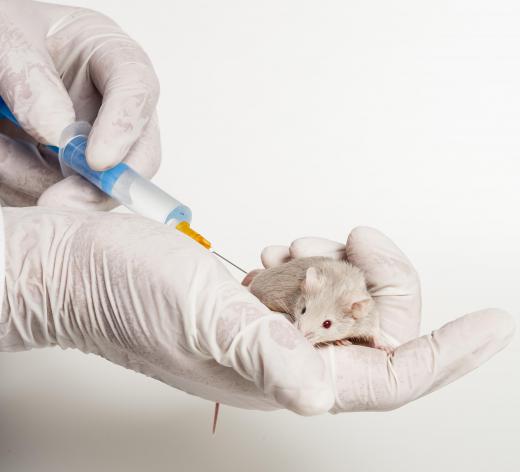What Is the Draize Test?
A Draize test involves using animal subjects to test the irritant levels of cosmetic, household, or pharmaceutical products. Developed in 1944 and named for American pharmacologist John Henry Draize, the two types of tests most commonly used include the Draize eye test and the Draize skin test. Labs may use different animal species for research test purposes, but the animal most often preferred has been the rabbit. In 2011, some laboratories have adopted testing procedures that do not require live animals.
Researchers wanted to learn about the possible irritating effects that various products have on living tissues. The Draize test exposes live animals to these substances and monitors the resulting damage. Rabbits became popular subjects for eye irritation tests, as they have no tear ducts, and therefore no tears, to wash away caustic solutions. Technicians typically placed the rabbits in a type of enclosure exposing only the head. Metal or plastic clips placed on the lids usually kept the eyes from blinking or shutting.

With anywhere from six to nine rabbits firmly positioned, technicians would drip solution directly into the eyes of the animals. The concentrated solutions might contain flakes, powders, or liquid substances. Technicians would then monitor the effects of the solution on the corneal tissues. Observation times typically occurred at regular intervals and might last over a course of days.The longest recorded Draize test supposedly transpired over a time period of 18 days.

Scientists have historically used a number of different animal species for skin corrosion tests. This type of Draize test generally required shaving a sizable patch of the test subject’s fur. The skin below then received an abrasion, often by firmly applying adhesive tape directly to the skin. A technician rapidly removed the tape and repeated the process until a sufficient amount of dermal abrasion had occurred.
The test product was then applied to the skin and the type and degree of skin corrosion that occurs was monitored. The test animals were generally restrained in a manner that prevented removal of the irritant. Over a designated period of time, the results were monitored and recorded.
As an alternative to the Draize test, organizations like the Cosmetic, Toiletry and Fragrance Association, finance other means of testing products. These organizations promote growing the necessary tissues from cell cultures. Some companies have developed methods of growing epidermal keratinocytes into stratified squamous epithelium that is similar to corneal or dermal tissue. Research labs may also obtain animal and human corneal tissue from eye banks.
AS FEATURED ON:
AS FEATURED ON:












Discuss this Article
Post your comments